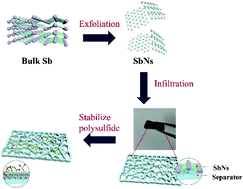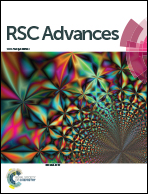Sb nanosheet modified separator for Li–S batteries with excellent electrochemical performance†
Abstract
An air-stable antimony (Sb) nanosheet modified separator (SbNs/separator) has been prepared by coating exfoliated Sb nanosheets (SbNs) successfully onto a pristine separator through a vacuum infiltration method. The as-prepared Li–S batteries using SbNs/separators exhibit much improved electrochemical performance compared to the ones using commercial separators. The coulombic efficiency (CE) of the Li–S battery using the SbNs/separator after the initial cycle is close to 100% at a current density of 0.1 A g−1, and 660 mA h g−1 capacity retained after 100 cycles. The rate capability of Li–S battery using SbNs/separator delivers a reversible capacity of 425 mA h g−1 when the current density increases to 1 A g−1. The improved electrochemical performance is mainly attributed to the following reasons. Firstly, the combination of physical adsorption and chemical bonding between SbNs and lithium polysulfides (LiPSs), which efficiently inhibits the shuttle phenomena of LiPSs. Secondly, the good electronic conductivity of SbNs improves the utilization of the adsorbed LiPSs, which benefits the capacity release of active materials. Lastly, the fast conversion kinetics of intermediate LiPSs caused by the catalytic effect from SbNs further suppresses the shuttle effect of LiPSs. The SbNs/separators exhibit a great potential for the future high-performance Li–S batteries.



 Please wait while we load your content...
Please wait while we load your content...